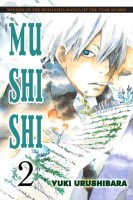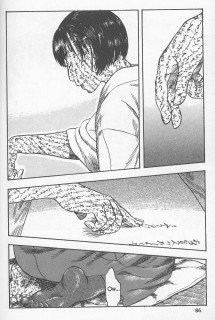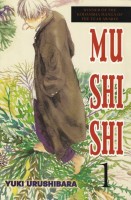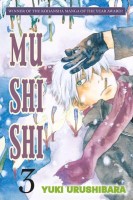 Creator: Yuki Urushibara
Creator: Yuki Urushibara
U.S. publisher: Del Rey
ISBN: 9780345496454
Released: February 2008
Original release: 2002
Awards: Japan Media Arts Award, Kodansha Manga Award
Mushishi, Volume 3 by Yuki Urushibara was originally published in Japan in 2002. The volume was initially released in English in print by Del Rey Manga in 2008. Although that particular edition is no longer available, Kodansha Comics did re-release Mushishi, Volume 3 digitally in 2014. I count myself lucky to own the entirety of Mushishi in print. I fell in love with the series after reading the first volume and so made a point to begin collecting it. Fortunately, Mushishi was being released in English around the same time I first started to really get into comics and manga and I didn’t have a difficult time finding the series. To this day, Mushishi remains one of my favorite manga. I like its quiet yet often creepy atmosphere and its folktale-like nature. I’m not the only one who appreciates Mushishi. The series was a recipient of a Kodansha Manga Award and has also been the basis for a live-action movie as well as multiple anime adaptations and other media.
Unseen to most people but found throughout nature are mushi—creatures that are still very close to the original form of life. They can be benign forces but often their presence is a source of trouble when it encroaches upon the human world. Illness and disease and even seemingly natural phenomena can all be attributed to mushi. Some people with the ability to see mushi make their living as mushishi by traveling across the country, studying the creatures, and trying to return balance where disturbances have occurred. But there are also those who can see mushi who are not mushishi. Frequently they are unaware of what the creatures truly are, and many times the people around them don’t believe them when they try to describe their experiences with mushi. This lack of understanding can cause significant strife, even within tightly knit communities. People who can see and are aware of mushi, whether they be mushishi or not, are treated differently, sometimes out of concern and sometimes out of fear.
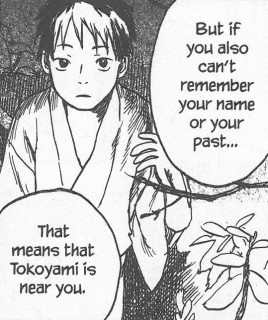 While the previous volume of Mushishi seemed to place a particular emphasis on mushishi, the fourth volume mostly features stories in which Ginko—a mushishi and the series’ protagonist—is dealing with incidents where people who can see mushi but who are not formally trained as mushishi are somehow involved. In “The Cry of Rust,” the unique quality of a young woman’s voice attracts mushi, bringing calamity to her village. “From the Ocean’s Edge” follows a man whose wife has been missing at sea for three years after they both saw peculiar creatures in the water. “The Heavy Seed” tells the story of a village that has strangely bountiful harvests during times of famine. Children fall deathly ill in “White Living in the Inkstone” when they accidentally release dormant mushi while playing in Doctor Adashino’s storehouse without permission. (Adashino is one of the very few recurring characters in Mushishi; his slightly antagonistic relationship with Ginko is absolutely delightful.)
While the previous volume of Mushishi seemed to place a particular emphasis on mushishi, the fourth volume mostly features stories in which Ginko—a mushishi and the series’ protagonist—is dealing with incidents where people who can see mushi but who are not formally trained as mushishi are somehow involved. In “The Cry of Rust,” the unique quality of a young woman’s voice attracts mushi, bringing calamity to her village. “From the Ocean’s Edge” follows a man whose wife has been missing at sea for three years after they both saw peculiar creatures in the water. “The Heavy Seed” tells the story of a village that has strangely bountiful harvests during times of famine. Children fall deathly ill in “White Living in the Inkstone” when they accidentally release dormant mushi while playing in Doctor Adashino’s storehouse without permission. (Adashino is one of the very few recurring characters in Mushishi; his slightly antagonistic relationship with Ginko is absolutely delightful.)
Although during serialization it followed “The Cry of Rust,” the final chapter collected in Mushishi, Volume 3 is “The Fish Gaze.” The episode is particularly notable because it reveals some of Ginko’s backstory. Even though it’s a past that he himself is unable to remember—a rare example of a time when the reader is more knowledgeable than he is—this specific part of Ginko’s life story plays a very important role in who he later becomes. Mushishi tends to be episodic, but elements of Ginko’s character and personality have been revealed throughout the series. However, “The Fish Gazee” is the first chapter to really delve into his history. Like many of the other stories in Mushishi, Ginko’s tale has elements of darkness and tragedy, but the emphasis placed on the ultimate perseverance of life in the face of death and sorrow remains. Mushishi frequently incorporates sadness, but the manga is not without hope; Urushibara seems to be able to navigate a fine balance between melancholy and wonder with ease.

